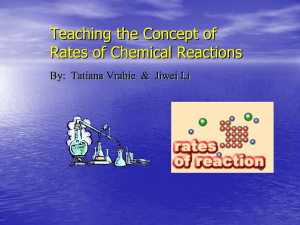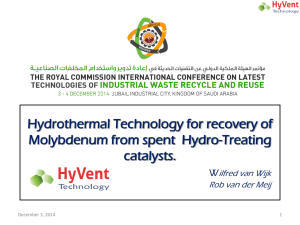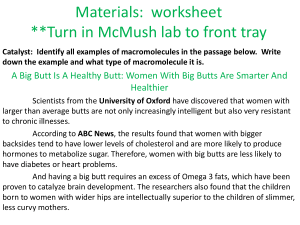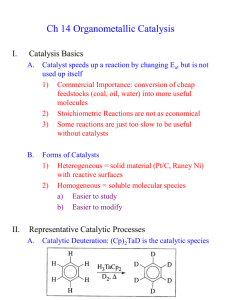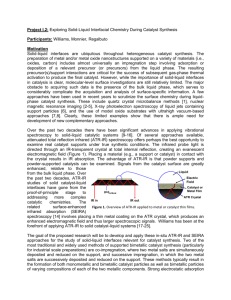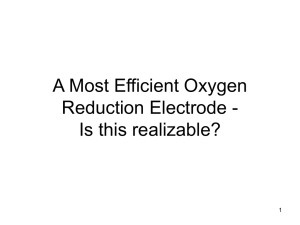catalysts - Anamet.cz
advertisement
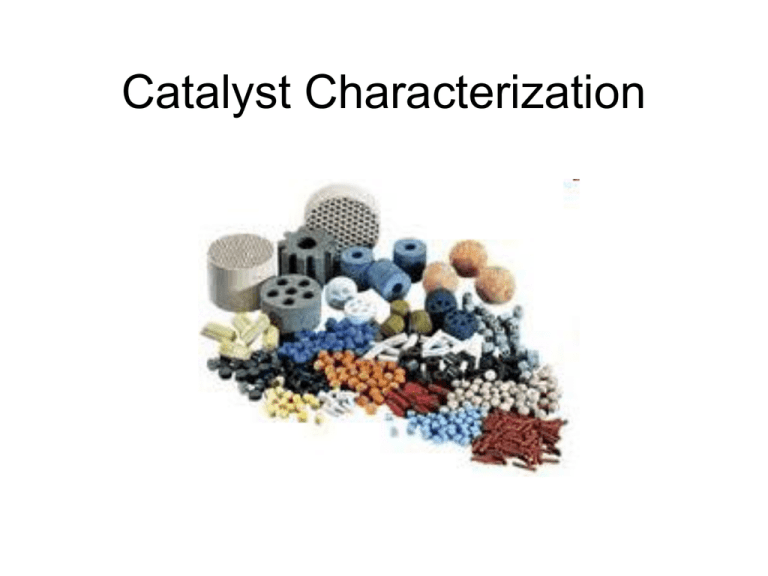
Catalyst Characterization Reactive gas adsorption • What can be measured using this technique? • Who would be interested in such results? • A brief overview of measurement fundamentals. • Catalysts • Instrument specific features of benefit to analyzing catalysts Reactive Gas Adsorption • What can be measured using these techniques? – Amount of reactive sites on a surface • Active metal area • Dispersion – – – – – – Nanocluster/crystallite size Heats of adsorption Ease of reduction (TPR) Ease of oxidation (TPO) Bond strength (TPD) Activation Energy Reactive Gas Adsorption • Who would be interested in such results? – Catalyst researchers • Chemists • Chemical engineers – Catalyst manufacturers – Catalyst users – Catalyst regenerators Reactive Gas Adsorption • Who would be interested in such results? – Petrochemical companies • Catalysts are used to produce higher octane gasoline • Catalysts are used to produce new products • New catalysts are needed to utilize biofuels – Automotive companies • Catalysts are used to reduce undesirable exhaust gases – Fuel cell companies • A fuel cell electrode is a catalyst for combining two chemicals Petrochemicals/Fine Chemicals Platinum reforming (aromatics in gasoline) Steam reforming (hydrogen production) Methanol synthesis (copper based) Plastics intermediates Desulfurization (cobalt-molybdenum) Aldehydes • • • • • • • • • • • • BASF Evonik Ineos Grace Davison Haldor Topsoe Johnson Matthey Interkat Bosch Chevron Criterion Delphi Engelhard • • • • • • • • • • • • Environex Exxon Mobil Honeywell Huntsman Hyperion Lyondell Sabic Shell Sud-Chemie Tricat UOP W.R. Grace Catalysts Idea : Catalysts utilize supports. • Typical Supports : • Silica/alumina • Clays • Zeolites • Carbon-graphite • Carbon black • Activated charcoal (carbon) • Titanium oxide • Supports have • Ample Surface Area • Correct Pore Size • Proper Chemistry (E.g Alumina Acidic) Reactant selectivity + Product selectivity CH3OH + Restricted transition-state selectivity Catalysts • Catalytic Converters : Automobile Exhaust – Catalyst (platinum, palladium and rhodium) on ceramic or metal support What does the catalytic converter do ? • Converts combustion by-products into safe, inert compounds. • Catalytically Converts CO (toxic) -> CO2 (safe) + H2O (safe) • Catalytically Converts NOx (toxic) -> N2 (safe) Fuel Cells Active Sites on a Catalyst • Metal on support. • Island-like crystallites • Not all metal atoms exposed. • Adsorption technique perfectly suited. (cf Chemical analysis of entire metal content ) Catalysts • Cracking process catalyzed by a zeolite : micropore structure responsible for activity/selectivity. Overview of Chemisorption Why is it necessary and who uses it? • Really, it’s a subset of the “regular” Autosorb business • Catalysts • Gas Storage • Fuel Cells What Techniques Exist • Flow • Vacuum What Instruments are available? • iQ – C with TCD and MS • Pulsar (ChemBET) How? Active metal area/dispersion by • Chemisorption Methods • Static • Flow Reducibility by • TPR (Temperature Programmed Reduction) Oxidizibility by • TPO (Temperature Programmed Oxidation) Acid site strengths by • TPD (Temperature Programmed Desorption) BET surface area, pore size distribution, true density, tapped density. Active Site Quantification • Because the formation of a chemical bond takes place between an adsorbate molecule and a localized, or specific, site on the surface of the adsorbent, the number of active sites on catalysts can be determined simply by measuring the quantity of chemisorbed gas Chemisorption • “Static” isotherms (manometric system) – Autosorb-iQ-C (auto) • “Pulse” titrations (flowing systems) – ChemBET (manual) – ChemBET Pulsar (auto) – Autosorb-iQ-C-TCD (auto) Preparation Techniques Sample is heated under inert flow to remove adsorbed moisture. While the reduction step creates moisture, we don’t want the reducing gas to compete for diffusion to surface. Reduce with H2: can be pure hydrogen or diluted with nitrogen or argon. Higher concentrations give higher space velocities for the same volumetric flow rate. Purge hot! Setup Filler rod goes here Quartz wool sample capillary Static (manometric) Setup adsorptives manifold Turbomolecular (drag) pump vent Flow “U” cell diaphragm pump furnace Vacuum Chemi – Autosorb iQ-C High Temperature Furnace Exit Flow Path • Often requires 750degC to activate/test • For Sample Treatment (Flow and heat) MFC Option Corrosive Gas Compatibility • Pretreatment / Analysis control • Typical Gas CO, NO2, H2 Turbo Molecular System / 10 Torr • For highly sensitive, low Pressure isotherms • Optional ??? Extrapolation Method First (only?)isotherm Volume Adsorbed Vm Pressure (mm Hg) The Second Isotherm Volume Adsorbed combined Weak only Pressure (mm Hg) The Difference Isotherm Volume Adsorbed combined Weak only Strong Pressure (mm Hg) Principles of Calculation Monolayer Volume, Vm = volume of gas chemisorbed in a monomolecular layer Metal Dispersion Dispersion is defined as the percentage of all metal atoms in the sample that are exposed. The total amount of metal in the sample is termed the loading, χ , as a percentage of the total sample mass, and is known from chemical analysis of the sample. Measure by reactive probe gas !!! Flow Chemisoroption Temperature Programmed (TP) Experiments • TP-Reduction • TP-Oxidation • TP-Desorption Flow Types of Analysis TPR A flow system permits multifunctional catalyst characterization : TPO TPD Monolayer by Titration BET active sites support Why TPR ? • How much energy (heat = $$) required to activate catalyst prior to startup of industrial reaction process ? • Metal Oxide Form no active • Catalyst must be reduced prior to use Temperature Programmed Reduction (TPR) • A low concentration of pre-mixed hydrogen (e.g.5%) in nitrogen or argon (or other reducing gas for custom research applications) flows over the sample as it is heated during a linear increase (ramp) in temperature. • The peak reduction temperature is also a function of heating rate and may be used to calculate activation energy for the reduction process. Temperature Programmed… Flowing systems • ChemBET • ChemBET Pulsar • Autosorb-iQ-CTCD Catalysts • Support : Zeolites – Framework formed, Si + O (tetrahedral arrangement) – Network of cages, cavities, channels • Responsible for catalytic activity. Catalysts • Characterization of Catalysts : NH3 TPD for Acid Site Determination Flow Chemi – Autosorb iQ-C with TCD OR Pulsar Flow Chemi, Setup (Pulsar) Flow Chemisorption System • No Vacuum • Uses TCD (GC Technology) • Gets metal area by same physical principle, but titration of surface Pulse Titration of Active Sites • • • • H2 or CO titration N2 and He carrier respectively Constant temperature (room temp?) Multiple injections until saturation H2 CO He N2 H H M H H M H M M Titration LOAD INJECT injections Surface Reaction by MS (linear Mass Spec. scale) TCD signal Surface Reaction by MS (linear Mass Spec. scale) TCD signal Flow Chemisorption Overview Detector senses • depletion of active gas from inert carrier gas during adsorption • evolution of previously adsorbed gas during desorption • decomposition products Signal detection • Standard: thermal conductivity detector • Optional: mass spectrometer What to Measure? Static Flow Multi-point BET surface area Single-point BET surface area Mesopore size distribution Micropore size distribution Physisorption enthalpy (isosteric heat) Vapor sorption isotherm (ads/des) Total (combined) chemisorption Strong (irreversible) chemisorption Weak (reversible) chemisorption Metal (active) area Nanocluster (crystallite) size Catalyst dispersion (based on strong chemi only) Effective dispersion including spillover Chemisorption enthalpy (isosteric heat) Activation energy (Kissinger/Redhead) Temperature programmed reduction (TPR) + + + + + + + + + + + + + + - + + + + + + + AS-iQTCD + + + + + + + + + + + + + + + + Temperature programmed oxidation (TPO) - + + Temperature programmed desorption (TPD) - + + Temperature programmed reaction (TPSR) - + + 60% + 55% + 100% Property Acid site strength (relative distribution) Fulfillment Which Instrument Offers What? QC ChemBET QC Pulsar QC iQ-C QC iQ-C TCD - Static - - Full Physi - - Furnace maximum 1100 1100 1100 1100 Furnace cooling - Loop injection Manual Auto - Auto (option) Mass flow controller External option External option Internal option External option Flow (TCD incl)



